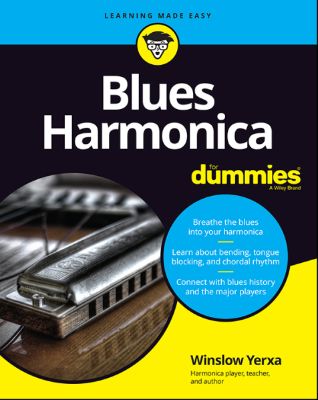
Lýsing:
Breathe the blues into your harmonica Learn about bending, tongue blocking, and chordal rhythm Connect with blues history and the major players The fun and easy way to play blues harmonica Blues Harmonica For Dummies gives you a wealth of guidance on playing harmonica in the style of the blues masters. Learn how to go from playing easy chords to strong single notes — and then to 12-bar blues. Develop your personal style and put together a repertoire of tunes to play for an audience.
Explore specific techniques and applications, including bending and making your notes sound richer and fuller; using amplification; developing blues licks and riffs; performing a blues harmonica solo like a pro; and much more. Inside. . . A review of the blues as a musical style What it takes to get started A blues guide to music symbols Ways to shape, color, and punctuate your blues sound How to amplify your playing Important blues players and recordings.
Annað
- Höfundur: Winslow Yerxa
- Útgáfa:1
- Útgáfudagur: 2020-07-14
- Hægt að prenta út 10 bls.
- Hægt að afrita 2 bls.
- Format:ePub
- ISBN 13: 9781119748922
- Print ISBN: 9781119694519
- ISBN 10: 1119748925
Efnisyfirlit
- Cover
- Introduction
- About This Book
- Conventions Used in This Book
- What You’re Not to Read
- Foolish Assumptions
- How This Book Is Organized
- Icons Used in This Book
- Where to Go from Here
- Part 1: So You Wanna Play Blues Harmonica?
- Chapter 1: Connecting with the Blues
- What the Blues Is All About
- Why the Harmonica Is Cool All on Its Own
- What It Takes to Get Started
- Digging in on Blues Harmonica: Getting Your Playing Going
- Chapter 2: Getting Your Harmonicas Together
- Finding Good Harmonicas for Playing Blues
- Acquiring the Most Useful Keys and Types of Harmonica
- Organizing and Protecting Your Harmonicas
- Keeping Your Harmonicas in Good Working Order
- Chapter 3: Deciphering the Code: A Blues Guide to Music Symbols
- Getting to Know the Shorthand of Harmonica Tab
- Understanding Musical Time
- The ABCs of Melody and Harmony
- Shaping Musical Statements
- Communicating with Other Musicians
- Chapter 1: Connecting with the Blues
- Chapter 4: Breathing Life into the Harmonica
- Preparing Your Body and Your Mind
- Adding the Harmonica
- Making Your First Musical Sounds
- Chapter 5: Moving Around with Single Notes
- Isolating a Single Note with Your Lips
- Singling Out a Note with Your Tongue
- Making Your First Moves
- Playing Your First Blues Phrases
- Chapter 6: Creating Blues Harmonica Licks and Riffs
- Combining Breath Changes and Hole Changes
- Getting Acquainted with Licks and Riffs
- Building Licks and Riffs with Pathways
- Chapter 7: Progressing Through the 12-Bar Blues
- The Three Parts of 12-Bar Blues
- Relating Each Part of the Verse to the Harmonica’s Chords
- Shaping Your Statements in 12-Bar Blues
- Chapter 8: Working with the Low and High Registers of the Harmonica
- Getting Low and High Notes to Sound Clearly
- Unlocking the Power of the Low Register
- Demystifying the High Register
- Chapter 9: Modulating and Punctuating Your Sound
- Starting and Stopping Notes with Articulation
- Making Vowel Sounds
- Undulating Your Sound with Vibrato
- Chapter 10: Enriching Your Sound with Textures
- Playing Warbles and Shakes
- Mastering Tongue Action
- Chapter 11: Bending Notes: A Classic Part of the Blues Sound
- Acquiring the Knack
- Moving to and from Bent Notes
- Mapping All the Bends
- Playing Your Bends in Tune
- Bending in the Low Register
- Bending in the High Register
- Bending on the Chromatic
- Bending Notes Up with Overblows and Overdraws
- Chapter 12: Playing in Different Keys on a Single Harmonica
- Introducing the Position Concept
- An Overview of First, Second, and Third Positions
- Chapter 13: Working Your Blues Chops in First Position
- Relating First Position to the Three Chords of the Blues
- Navigating the Three Registers in First Position
- Bearing Down on Blue Notes and Bendable Notes in First Position
- Exploring Pathways to First-Position Licks and Riffs
- Three First-Position Study Tunes
- Chapter 14: Accelerating the Blues with Third Position
- Relating Third Position to the Three Chords of the Blues
- The Three Registers in Third Position
- Blue Notes and Bendable Notes in Third Position
- Exploring Pathways to Third-Position Licks and Riffs
- Three Third-Position Study Tunes
- Chapter 15: Playing Blues Chromatic Harmonica in Third and First Positions
- Why Play Chromatic? Getting Accustomed to Its Face
- Third Position Blues Chromatic: Tongue Blocking Is King
- Using the Slide
- First Position Blues Chromatic
- Chapter 16: Playing Blues in Minor Keys
- What Is a Minor Key?
- Making Minor Keys Easy with Minor Keyed Harmonicas
- Using Familiar Positions to Play in Minor Keys
- Getting Hip to Minor Positions
- Chapter 17: Groovin’ with Non-12-Bar Blues
- Strategies for Adapting to Different Song Forms
- The 8-Bar Blues Form
- Saints Go Marching In Form
- Chapter 18: Developing Your Blues Repertoire
- Learning by Ear from Blues Records
- Improvising a Blues Solo with Licks and Riffs
- Adding a New Harmonica Part to a Song
- Blues Harmonica Songs to Get in Your Ears
- Chapter 19: Blues Harmonica Amplification: Making a Big Noise with a Tiny Little Thang
- Two Major Approaches to Amplification
- Using Distortion and Avoiding Feedback
- Piecing Together the Amplification Chain
- Chapter 20: Ten Things to Know about Sharing Your Music with Others
- Five Ways to Collaborate with Other Musicians
- Five Tips for Delivering a Polished Performance
- Chapter 21: Ten Important Periods and Styles in Blues Harmonica History
- Early Harmonica History in the United States
- Prewar Rural Blues Harmonica
- Traveling Life and the Migration North
- Memphis and Early Urban Blues
- The Prewar Chicago Style
- The Rise of Amplified Blues Harmonica
- The Postwar Chicago Style
- Regional Harmonica Styles
- Rock, Blues, and the 1960s
- Modern Blues
- Appendix A: Tuning Layouts for All Keys
- Appendix B: About the Website
- Relating the Text to the Website Files
- System Requirements
- The Tracks on the Web page
- Troubleshooting
UM RAFBÆKUR Á HEIMKAUP.IS
Bókahillan þín er þitt svæði og þar eru bækurnar þínar geymdar. Þú kemst í bókahilluna þína hvar og hvenær sem er í tölvu eða snjalltæki. Einfalt og þægilegt!Rafbók til eignar
Rafbók til eignar þarf að hlaða niður á þau tæki sem þú vilt nota innan eins árs frá því bókin er keypt.
Þú kemst í bækurnar hvar sem er
Þú getur nálgast allar raf(skóla)bækurnar þínar á einu augabragði, hvar og hvenær sem er í bókahillunni þinni. Engin taska, enginn kyndill og ekkert vesen (hvað þá yfirvigt).
Auðvelt að fletta og leita
Þú getur flakkað milli síðna og kafla eins og þér hentar best og farið beint í ákveðna kafla úr efnisyfirlitinu. Í leitinni finnur þú orð, kafla eða síður í einum smelli.
Glósur og yfirstrikanir
Þú getur auðkennt textabrot með mismunandi litum og skrifað glósur að vild í rafbókina. Þú getur jafnvel séð glósur og yfirstrikanir hjá bekkjarsystkinum og kennara ef þeir leyfa það. Allt á einum stað.
Hvað viltu sjá? / Þú ræður hvernig síðan lítur út
Þú lagar síðuna að þínum þörfum. Stækkaðu eða minnkaðu myndir og texta með multi-level zoom til að sjá síðuna eins og þér hentar best í þínu námi.
Fleiri góðir kostir
- Þú getur prentað síður úr bókinni (innan þeirra marka sem útgefandinn setur)
- Möguleiki á tengingu við annað stafrænt og gagnvirkt efni, svo sem myndbönd eða spurningar úr efninu
- Auðvelt að afrita og líma efni/texta fyrir t.d. heimaverkefni eða ritgerðir
- Styður tækni sem hjálpar nemendum með sjón- eða heyrnarskerðingu
- Gerð : 208
- Höfundur : 16088
- Útgáfuár : 2020
- Leyfi : 379


